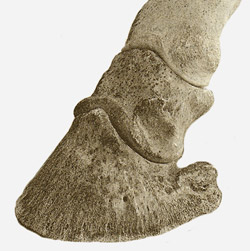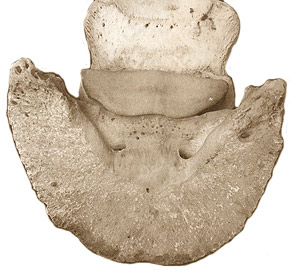
Symptoms and Diagnosis of Pedal Ostitis in a Horse or Pony
WHAT IS PEDAL OSTITIS?

Pedal Ostitis is the name given to inflammation of the bone inside the
horse's hoof, called the distal phalanx or pedal bone.
This can cause varying degrees and severity of lameness.
The pedal bone is the large bone in the hoof. It is the very end bone of the horse's leg and conforms in shape to the hoof to which it is attached.
The term Pedal Ostitis has been commonly applied to horses with obvious foot pain, no signs of navicular disease and a suspicion of changes in the pedal bone.
The pedal bone can become inflamed due to concussion and so the disease is more common in horses with flat feet and on hard ground.
Pedal Ostitis usually affects the front feet of the horse. It used to be diagnosed quite frequently, but now vets tend to prefer alternative diagnoses of ailments for the symptoms that are presented.
WHAT ARE THE SYMPTOMS OF PEDAL OSTITIS?
The main symptoms are lameness or shortness in step or lameness.
Other symptoms are an unwillingness to move forward, or refusing jumps on hard ground.
DIAGNOSING PEDAL OSTITIS IN A HORSE'S FOOT
In order to diagnose what is causing lameness a vet may decide to do
a nerve block to find out where the pain is coming from.
Once it is established that the pain is in the foot, the hoof will probably
be X-rayed. Several x-rays will be taken at varying angles.
If these X-rays show that the margin of the pedal bone is irregular or if the blood vessel channels through the bone are enlarged vets have traditionally viewed these changes as as evidence of degenerative disease of the pedal bone an have diagnosed pedal ostitis.
PROBLEMS WITH DIAGNOSIS OF PEDAL OSTITIS IN HORSES
 There are problems with
this diagnosis however, not least the fact that a great many normal horses
have irregular margins to their pedal bones and wide channels for the
blood vessels.
There are problems with
this diagnosis however, not least the fact that a great many normal horses
have irregular margins to their pedal bones and wide channels for the
blood vessels.
The edge of the bone is very variable in outline and commonly has notches and indentations, especially at the toe.
In any other bone this would indicate erosion. But in the pedal bone such a wavy irregular margin is normal.
There is a condition in which the pedal bone becomes inflammed and that this ostitis is best assessed by looking ar rhe side to side views on X-ray - instead of a flat smooth solar surface beneath the bone. Affected horses have evidence of new bone growth under the bone.
TREATMENT OF PEDAL OSTITIS LAMENESS
The best treatment for a horse with pedal ostitis is rest along with corrective shoeing so that it can recover from the bruising and inflammation.
YOur vet may prescribe anti-inflammatory drugs to provide pain relief. You can also try herbal remedies such as Devil's Claw.
CORRECTIVE OR REMEDIAL SHOEING FOR A HORSE WITH PEDAL OSTITIS
Co-operation between your farrier vet and can be the best way to treat pedal osteitis.
Often, horses with this condition have poor foot conformation and a degree of hoof imbalance.
Remedial shoeing for horses with pedal ostitis is aimed at reducing concussion in the foot and protecting the sole. Pads are a very useful way of doing this. Any farrier can put leather or plastic pads on a horse. Thes will help to absorb the shock of the hoof hitting the ground and will also cushion the sole of the foot.
A farrier will be able to assess the conformation of the hoof and may be able to recommend special shoes, such as wide webbed shoes.
HORSE CARE ADVICE AND EQUESTRIAN ARTICLES
Tack Shop Cornwall | Horse and Hound | Guide to types of lameness | Curb Bit | Shoulder Lameness |